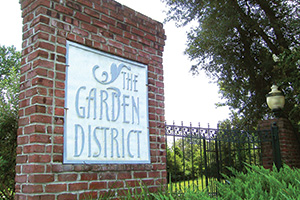A house that is raised looks grander,” says builder Dennis Collier. “It brings back the past. It's reminiscent of how our forefathers built houses before concrete came out."
Dennis Collier of Collier Construction has been building raised wood floor homes in Mississippi and Louisiana for 15 years. “Raised foundations give home owners the amenities of the present while embracing the style of the past,” says Collier, who has a reputation for incorporating new and efficient building products while maintaining the character and historical feel of traditional homes.
For the Garden District, a 33-lot development in Picayune, Mississippi, Collier wanted to “put a sense of unity back into the community.” He envisioned a traditional neighborhood with craftsman-style homes that would reflect the character and class of the South. The charm and hospitality of a front porch, a natural extension of a raised wood floor home’s living space, was a big part of Collier’s vision.
The houses have raised front porches, and we put the sidewalks close to the porches with wrought-iron gates,” explains Collier. “It’s just more personal. People sit out on the front porch and they talk to their neighbors, to someone passing by the gate or walking their dog.”
 “It’s like grandma’s front porch. It’s just inviting. It says, come on up and share a glass of tea,” says Collier. “Aesthetically, to me and my customers, raised wood floors are just pleasing to the eye.
“It’s like grandma’s front porch. It’s just inviting. It says, come on up and share a glass of tea,” says Collier. “Aesthetically, to me and my customers, raised wood floors are just pleasing to the eye.
Aesthetics, Collier claims, help him turn a greater profit. “I did a test. I built two houses, one was raised and one was on a slab. Everything else was the same, but the raised floor sold faster and for more money than the slab.”
It also cost less to build, says Collier. Slab systems often require bringing in fill dirt – an expense that has increased in recent years due to soaring fuel costs. “Today we pay nearly twice as much for a load of dirt than we paid just a few years ago. There is an old saying that dirt is cheap. Well it’s not true!” Collier says. “That’s why I love building raised. I can eliminate that extra cost and time. I don’t have near the delays as I do when I pour a slab.”
Raised Wood Floors Lower Costs for Habitat for Humanity
When Dennis Collier built eight houses for Habitat for Humanity in Picayune, Mississippi, local flood ordinances did not require the houses to be raised. Collier, however, convinced the nonprofit Christian housing ministry that raised wood floors would save money. “Building raised was the cheapest way to go,” says Collier. “We did a cost analysis and they agreed. I was able to save them about $860 per house. Multiply that amount by eight and it’s a pretty good chunk of savings – especially for smaller homes!”